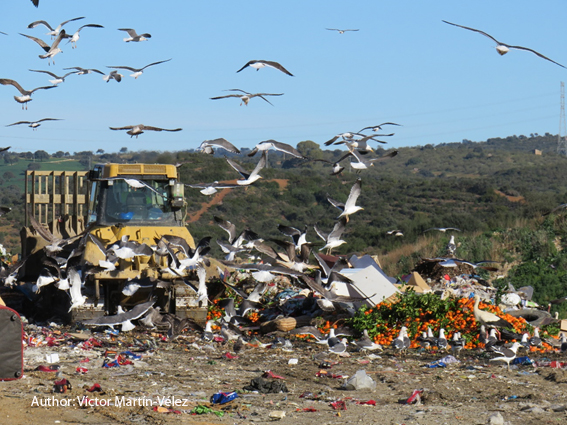The lesser black backed gull Larus fuscus is now the second most abundant wintering waterbird in Andalusia, and has increased in numbers in recent years. Fuente de Piedra, the biggest shallow lake in Andalusia and a Ramsar site famous for its flamingo colony, is the principal gulls roosting site in midwinter. Gulls are the most important source of nitrogen and phosphorus inputs to the lake during winter through their guano, and feed in four landfills up to 80 km away in Málaga and Córdoba provinces according to GPS data. This study has quantified the amount of nutrients gulls import to Fuente de Piedra lake. The obtained results provide a vital step to understand the effects of waterbirds in so called "guanotrophication". Gulls take advantage of easy pickings at landfills for feeding, so they can transport an important amount external of nutrients to the lake, where they spend a large proportion of the day. GPS data were used to determine at which landfills gulls were feeding, and the relative importance of each. Although gulls are regularly counted at the lake, gulls are early risers and GPS data showed that most of them had already flown off towards landfills when counting was carried out, and this allowed correcting the counts for missing birds. Movement data were also used to estimate the amount of daytime gulls spent at the lake over different winters, which determines how much of their guano is deposited in the lake. Laboratory analyses of faeces and pellets completed the calculations of nutrient inputs. As estimated in this study, gull contribution seems to be the most important nutrient source in winter with about 10 kg of nitrogen per Ha and 2 kg of phosphorus per Ha. This may bring implications within the ecosystem, whose state seems already eutrophied. Gull excreta is rich in nitrogen and phosphorus, which combined with other nutrient sources such as flamingos, run-off or inputs from the town's Wastewater Treatment Plant, may lead to an excess of nutrients in the lake. There are signs this has caused effects such as the loss of higher plants and a boom in algae. The water levels of Fuente de Piedra vary a lot from one year to another, and low water levels may increase the impact of gull guano. The study found that gulls preferred to spend more time in the lake when water levels were around 30 cm, when islands were available for roosting, and this can lead to increases in nutrient concentrations. This is the first time GPS data is combined with other methods to determine the origin and quantities of nutrients into aquatic systems, and it is the first step to understand the connection between anthropogenic landfills with aquatic bodies. informacion[at]ebd.csic.es: Martín-Vélez et al (2019). Quantifying nutrient inputs by gulls to a fluctuating lake aided by movement ecology methods. Freshwater Biol https://doi.org/10.1111/fwb.13374
https://onlinelibrary.wiley.com/doi/full/10.1111/fwb.13374








 Las altas temperaturas están provocando que las lagunas y las marismas de Doñana pierdan agua rápidamente
Las altas temperaturas están provocando que las lagunas y las marismas de Doñana pierdan agua rápidamente



